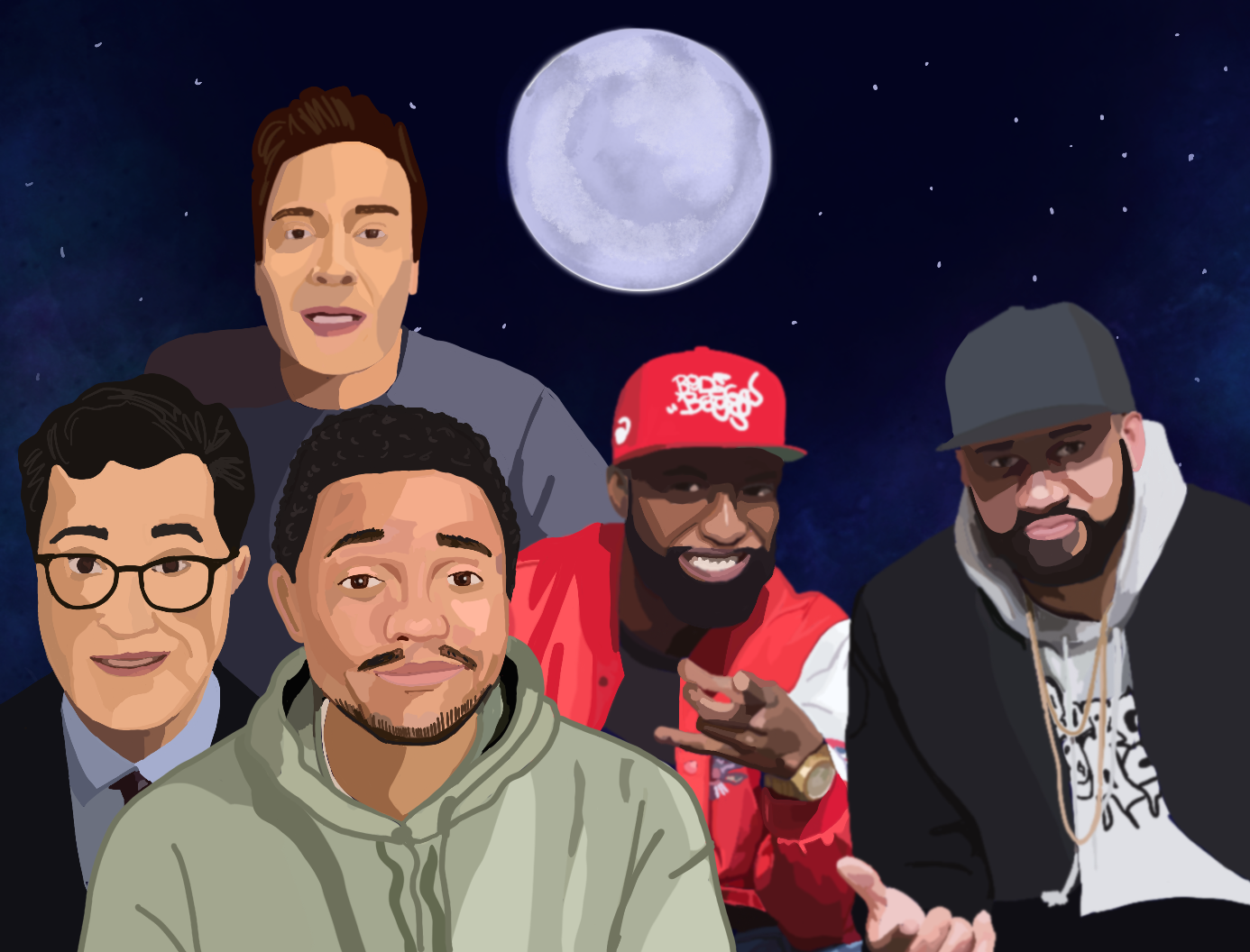Second Take: Late-night shows continue cultivating comedy, creativity with at-home formats

(Emily Dembinski/Daily Bruin)

By EJ Panaligan
May 20, 2020 1:44 p.m.
Late-night hosts are in quarantine just like their audiences – but “pre-recorded from home, it’s ‘Saturday Night’” just doesn’t have that same ring to it.
With social distancing measures forbidding large gatherings, studio audiences quickly diminished down to only the shows’ staff members or no audience at all. Back in March, former presidential candidate Pete Buttigieg guest hosted “Jimmy Kimmel Live!” to a spread-out audience of Kimmel staffers, friends and his husband. That same night, “The Daily Show” host Trevor Noah sang a goodbye tribute to his studio audience. The landscape of late-night was changing rapidly, but many of these shows persisted where they could, bringing humor to the United States during a time when it needed them most.
And because the ascending severity of the pandemic forced much of the United States to stay at home, a sudden and hastily concocted transition into the digital realm began for late-night shows whose core identities lived within studio walls and live audiences.
[Related: Second Take: TikTok is savagely redefining rap music’s cultural significance]
Thankfully though, most late-night shows haven’t seemed to miss a beat during this early transition period as hosts adjusted to recording their shows at home, often with only their show producers serving as their audiences over Zoom. In fact, the new digital realm has forced many of these shows to fervently dig deep into their creative pockets in order to keep their output fresh and exciting within this looser format. For example, the final sketch of the 45th season of NBC’s “Saturday Night Live,” titled “Dreams,” features liberal use of green screens to depict cast members’ humorous but poignant dream scenarios of what they miss the most about life in New York City before the pandemic started.
And while these unfortunate times have put a hold on Hollywood, it’s wholeheartedly admirable that late-night comedy shows have adapted to these new spaces to continue providing the U.S. with some much-needed laughs.
As easy as it may seem for a late-night host to set a camera down on a table, hit record and start monologuing – it’s not. The loss of a live studio audience could have proved detrimental for many of these hosts who have spent prior years feeding off crowd energy on the stand-up stage. Conversely, SHOWTIME hosts Desus Nice and The Kid Mero have found their comedic energy over the years through the immediate feedback of riffing off each other in person, which now has to be replicated over Zoom with minor lag.
But even despite the mountains of technical difficulties, the makeshift aesthetic of these shows’ early quarantine efforts will always highlight a sincere desire on their end to make things work. Jimmy Fallon’s wife Nancy serves as the camerawoman for his “At Home Edition” monologues, Stephen Colbert did his first at-home monologue in his bathtub and Kimmel recorded his monologues directly from his phone before he was able to start using a proper green screen setup. The early transition period for these shows could have resulted in disastrous, disjointed messes, but late-night hosts made use of what – and who – they could.
Concurrently, such makeshift efforts have fueled a heightened sense of homeliness and togetherness for audiences. Hosts and guests are typically seen in proper suits and fancy dresses with studio lights blaring upon them, but audiences are instead getting peeks into their home lives as they – and their A-list celebrity guests – share what they’ve been doing with their families to pass the time at home in quarantine.
[Related: Second Take: Quibi bites off more than it can chew in attempt to make streaming more accessible]
In that same vein, quarantine has forced many of these late-night shows to explore new avenues of creativity that otherwise would have never been discovered. “DESUS & MERO” aired a fully animated interview with writer Malcolm Gladwell along with a Zoom cookalong with The New York Times food columnist Alison Roman – both which were efforts cultivated from the circumstances presented by the pandemic.
Similarly, “Saturday Night Live” completely revamped its structure and reneged on many of its long-standing traditions in order to produce three at-home shows between April and May. The shows were filmed beforehand, and the cast’s inability to perform inside Studio 8H has stretched the show’s creative limits to take on more of an amateur “early YouTube sketch comedy-style” approach.
New cast member Chloe Fineman – who had a standard-fare first year on SNL with limited opportunities to perform – was able to stand out in the at-home format by filming solo sketches focused entirely on her impersonations. She produced parody MasterClass sketches featuring comical impersonations of actor Timothée Chalamet and screenwriter Phoebe Waller-Bridge, among others – all of which found a spotlight in SNL’s at-home format.
Even with this new transition, “Saturday Night Live” proved it is still the cultural touchstone it has been for more than 40 years. The show’s comedic portrayal of life in quarantine – along with Michael Che’s and Colin Jost’s pointed commentary on coronavirus-related news during its “Weekend Update” segments – highlighted a strong understanding of the public consciousness and zeitgeist even amid a global pandemic.
While it could be argued that these late-night comedy shows haven’t been the same as their traditional studio counterparts – and are therefore less enjoyable – it would be irrational to discredit them for a lack of effort.
It’s impossible to recreate a one to one copy of each show’s respective formats, but they are all trying, despite the technical hiccups. The balance these shows have found in sticking to their traditional structures while expanding the creative limits that the digital realm can offer has ultimately made for innovative, gut-busting and fascinating television in the coronavirus era.
The collective work of late-night shows proves that comedy will ultimately have its healing effect on a distressed, pandemic-stricken country – no matter what, where, when or how it’s produced.

